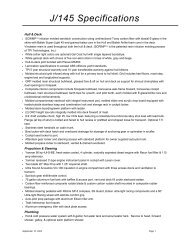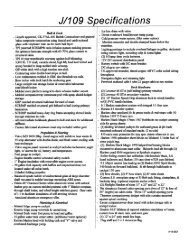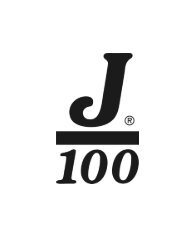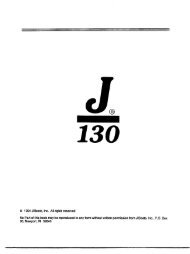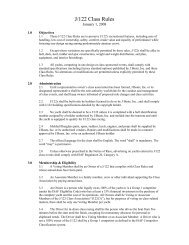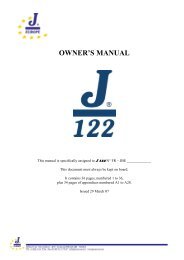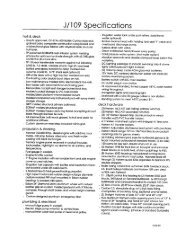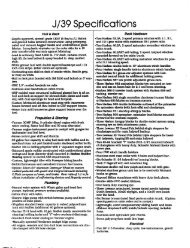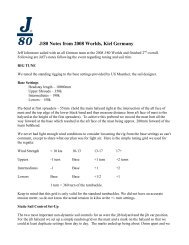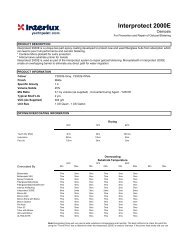J124 Owner Guide.pdf - J/Owners
J124 Owner Guide.pdf - J/Owners
J124 Owner Guide.pdf - J/Owners
- No tags were found...
Create successful ePaper yourself
Turn your PDF publications into a flip-book with our unique Google optimized e-Paper software.
J/124 OWNER MANUAL 37Coolant system: The filler cap (it looks like a radiator cap) for the freshwater-and-antifreeze cooling systemis located on top of the engine manifold. Check the coolant level of the manifold and the coolant sub-tankaft of the engine, (check when the engine is cool). When adding coolant, follow the engine manufacturer’srecommendations for the proper fresh water/antifreeze ratio. In climates where freezing may occur in winter,test the coolant mixture for freezing point. Add coolant as needed if the system is not drained for winterstorage.Raw-water system: Located in the engine compartment, the J/124’s raw-water strainer helps preventclogging of the raw-water cooling system and overheating of the engine. Check the strainer basket often toinsure that the flow of cooling water is unimpeded. Unscrew the strainer basket lid, remove the strainer andclean it, and be sure that the basket is seated properly in the bowl before screwing the lid on hand-tight.Engine Compartment VentilationDo not obstruct or modify any ventilation system or openings for the engine compartment.Exhaust SystemThe J/124 is equipped with a water-injected water-lift exhaust system that dissipates exhaust heat and actsas the exhaust muffler. Cooling water can accumulate in the bottom of the water-lock muffler; when decommissioningyour boat for the season, the muffler either should be drained by unscrewing the drain plugon the bottom of the muffler, or antifreeze should be added so that residual water doesn’t freeze.General Hints To Avoid Problems• Monitor brightness of cabin lighting and charge battery as required by running engine. Batteries arecharged by either running the engine or by an optional AC battery charger.• Stop engine by pushing engine stop button on panel, then turn ignition key “off”.• NEVER turn engine battery switch to OFF position while engine is running as this could damage thealternator.• For best performance and fuel economy a cruising R.P.M. of 2,600 - 2,800 works well. Vary RPMlevels periodically when cruising under power for a long distance. Be sure to thoroughly read andfollow the manufacturer’s manual for proper break-in procedure for the standard Yanmar Diesel engine.• Do not run engine at full throttle for sustained periods, as breakdown may occur. Most importantly, findan RPM that runs smoothly and follow the Yanmar guide. Avoid "vibrating" RPM speeds whenpossible.• Keep engine gear shift lever in "REVERSE" position while sailing to prevent possible "free-wheeling" ofprop• CAUTION: The J/124 engine is very quiet, and it is possible to forget that it is running. Before shiftingthe gear shift lever into REVERSE when sailing, double check that the engine is turned off.Engine Safety PrecautionsDue to high temperatures it is recommended that after running the diesel for more than two hours youreduce speed to idle and allow excess heat to dissipate for five to ten minutes.The most common cause of trouble is contaminated or dirty fuel. Your boat is equipped with a primary fuelfilter located in the engine compartment and a secondary filter on the engine. The wise skipper carriesreplacement filter cartridges. Familiarize yourself with the bleeding procedure for the engine and try



